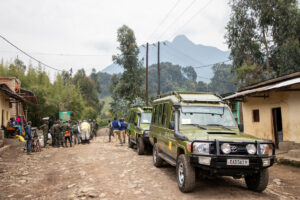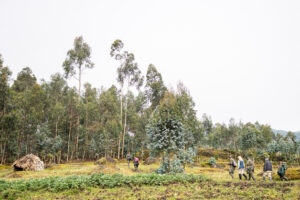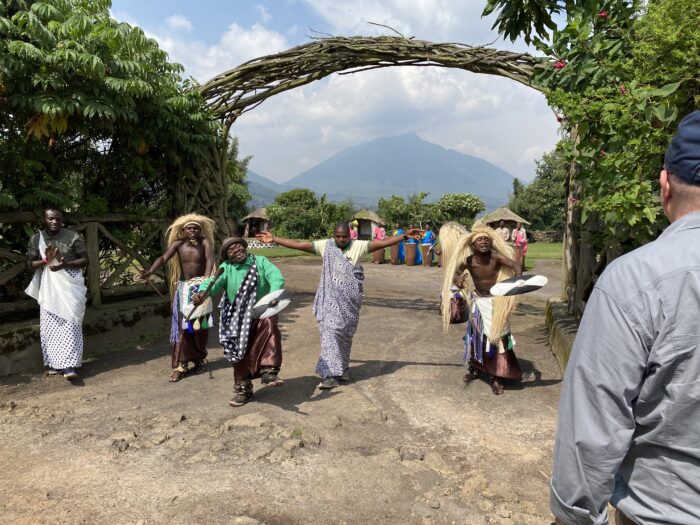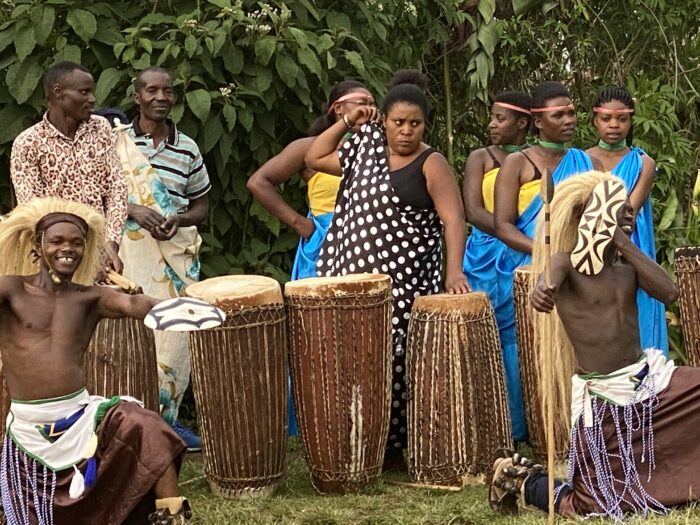
According to Skilled Adventurer, trekking is a “long arduous journey, typically on foot” that can test your ability and sanity. Hiking, on the other hand, is walking a long distance, usually on trails or roads. Neither involve safari vehicles that deposit visitors at the end of the road and fade from sight, seemingly forever.
I came to Rwanda hoping to encounter gorillas. I knew the visit would involve hiking and trekking. I just didn’t understand what that meant.
The world population of Silverback Mountain Gorillas (Gorilla Gorilla Berengie) is between eight and nine hundred individuals who live in the upper elevations of the Virunga Mountains of Central Africa. Their habitat area encompasses Volcanoes National Park in Rwanda, Mgahinga Gorilla National Park in Uganda, and Virunga National Park in the Democratic Republic of Congo. The gorillas, of course, don’t recognize national boundaries.

Gorilla tourism is important to the Rwanda economy, generating $19.2 million in 2018. It also protects the gorillas. In 1985 when Dian Fossey was killed, there were only three hundred gorillas left. Thanks to tourism, gorilla numbers are increasing. Dian, by the way, was opposed to gorilla tourism because it exposes gorillas to human disease.
Most families near Volcanos National Park have at least one family member employed in association with the park. Individuals might be rangers, trackers, or porters. Or they might be employed in the hotel and resort industry. Employment gives everyone a vested interest in protecting the gorillas from poachers. I was told many employees, or members of their families, are former poachers.
Our group was divided into three smaller groups before we departed from the lodge. The fittest group had the longest trek. Fortunately, I wasn’t in that group. I found our shorter trek daunting enough.
When we arrived at the vehicle drop off point, porters met us. They carried our packs, which in my case had two bottles of water and a sandwich. But the porters’ main job was to help us trek up the mountain and then get us back down again. My porters definitely earned their pay.

We began with a hike over open ground interspersed with cultivated land until we reached a stone wall. The wall is to keep buffalo and other animals from trampling the cultivated area. Sometimes elephants knock down the walls, and buffalo get through. When that happens, the park compensates farmers for their losses.
The wall also marks the official entrance to the park where we meet our rangers who remind us of the rules. Don’t look a gorilla in the eye or point at them. Stay a minimum of seven meters away from the gorillas. If a gorilla charges at you, drop to the ground immediately. No camera flashes.
We enter the park. The wall is a steep climb up, and equally steep going down. Next is a bamboo bridge, which looks more like a partial bridge. And then we begin to climb.
The path was a trough of oozing mud — the kind with suction so you have to lift your foot straight up with each step. The footing is easier if you straddle the mud on either side, but it’s hard to stay on balance. The porters keep me upright. They grab my hands, grip my upper arms, and, at certain points, told me to put my arms around their shoulders.

We climb, climb, climb until we reach a clearing where we leave the porters behind and meet the trackers. These men follow the gorillas all day, go home at night, and find them again the next day. Their job is to be sure the tourists have a gorilla encounter. They also clear our way with machetes. Off we trek. And then, we see the gorillas nonchalantly eating.

The rangers make a guttural sound in the back of their throats to assure the gorillas all is well. The gorillas continue pulling bamboo leaves off their stems stems and eating them. We saw a mother with her infant who was one or two months old. The infant samples bamboo, but mostly she plays. Mothers nurse infants for about three years.
Gorillas are solitary eaters, though there may be several individuals in an area. We observe three or four individuals who sometimes seem to surround us. The gorillas don’t know about the seven meter rule. One individual decides to leave one area of bamboo for another and brushes by me, so close I could easily have reached out to feel its fur.

Our hour time limit is up. Time to start the trek back. A tracker with a machete slashes a pathway through the forest. I’m glad he knew where we were, because I had no idea. Eventually we meet up with the porters and begin slogging downhill through the mud. We finally cross the bamboo bridge, climb over the wall, and drag ourselves back to the vehicles.
Poachers and loss of habitat are the greatest threat to mountain gorillas. The poachers are after antelope and buffalo, but gorillas get entangled in their snares. Rangers find, on average, one hundred traps each month. Gorilla infants are in high demand on the black market and can be sold for up to $5000. Gorillas will fight for their young, so poaching an infant can result in several deaths.
Iby-ewacu Cultural Village Center

Much of park revenue goes to the fight against poaching both through employment opportunities and creating other forms of revenue streams. One example is the Iby-ewacu Cultural Village Center, also known as the Gorilla Guardian Village. Iby-iwacu is a Kinyarwada word meaning “treasures of our home and heritage.” Many of the cultural interpreters are former poachers. Now they earn their living through tourism.
The emphasis is on traditional music and dance. In the demonstration village, visitors go to each hut and learn about various traditional crafts. Our group especially liked the demonstration of brewing banana beer. The result is 40% proof, and there were free samples. In another area, traditional housing not only shows how people once lived, but is also available as vacation rentals.
I took this short video of the musical performance.
Mountain Gorillas in Rwanda. Volcanos National Park Rwanda
Visiting the Iby-iwacu Cultural Village Centre. Mission Africa Safaris
“What are the differences between hiking and Trekking?” Skilled Adventurer
Kevin Sack. “Trekking with the Gorillas of Rwanda.” New York Times. Oct 23, 2015.
Julius Bizimungu. “Revenue from Gorilla Tourism Grows.” The New Times. Aug. 22, 2019.
Travel Arrangements by Abercrombie & Kent.

Sandra Wagner-Wright holds the doctoral degree in history and taught women’s and global history at the University of Hawai`i. Sandra travels for her research, most recently to Salem, Massachusetts, the setting of her new Salem Stories series. She also enjoys traveling for new experiences. Recent trips include Antarctica and a river cruise on the Rhine from Amsterdam to Basel.
Sandra particularly likes writing about strong women who make a difference. She lives in Hilo, Hawai`i with her family and writes a blog relating to history, travel, and the idiosyncrasies of life.





